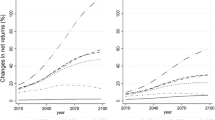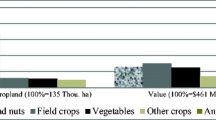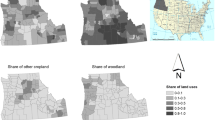Abstract
This paper examines possible adaptations to climate change in terms of pasture and crop land use and stocking rate in the United States (U.S.). Using Agricultural Census and climate data in a statistical model, we find that as temperature and precipitation increases agricultural commodity producers respond by reducing crop land and increasing pasture land. In addition, cattle stocking rate decreases as the summer Temperature-humidity Index (THI) increases and summer precipitation decreases. Using the statistical model with climate data from four General Circulation Models (GCMs), we project that land use shifts from cropping to grazing and the stocking rate declines, and these adaptations are more pronounced in the central and the southeast regions of the U.S. Controlling for other farm production variables, crop land decreases by 6 % and pasture land increases by 33 % from the baseline. Correspondingly, the associated economic impact due to adaptation is around −14 and 29 million dollars to crop producers and pasture producers by the end of this century, respectively. The national and regional results have implications for farm programs and subsidy policies.




Similar content being viewed by others
Notes
The Census of Agriculture reports come out each 5 years, so 2007 is the most recent report available.
See Pratt and Rasmussen (2001) for definition and calculation of the stocking rate for each animal.
For example, when the dependent variable in our model is from 1987, we use the seasonal averaged climate over 1985–1987, and similarly with the other four agricultural census data.
\( THI = 0.8*Ta + \left( {RH/100} \right)*\left( {Ta - 14.3} \right) + 46.4 \), where\( RH = \left( {6.1121} \right)*{e^{ \wedge }}\left( {18.678 - Ta/234.5} \right)\left( {Ta/\left( {257.14 + Ta} \right)} \right) \) and Ta = temperature in °C and RH is the relative humidity. When we construct the THI index, we convert our temperature data in to Celsius degree.
This assumption is strong. However, we use it to evaluate economic values as a reference level.
References
Adams RM, Rosenzweig C, Peart RM, Ritchie JT, McCall BA, Glyer JD, Curry RB, Jones JW, Boote KJ, Allen LH (1990) Global climate change and U.S. agriculture. Nature 345:219–224. doi:10.1038/345219a0
Bohmanova J, Misztal I, Cole JB (2007) Temperature-humidity indices as indicators of milk production losses due to heat stress. J Dairy Sci 90:1947–1956
U.S. Climate Change Science Program (2008) The effects of climate change on agriculture, land resources, water resources, and biodiversity in the United States. A report by the U.S. climate change science program and the subcommittee on global change research
Dikmen S, Hansen PJ (2009) Is the temperature-humidity index the best indicator of heat stress in lactating dairy cows in a subtropical environment? J Dairy Sci 92:109–116
Gourieroux C, Monfort A, Trognon A (1984) Pseudo maximum likelihood methods: theory. Econometrica 52(3):681–700
Hahn GL, Brown-Brand T, Eigenberg RA, Gaughan JB, Mader TL, and Nienaber JA (2005) Climate change and livestock: challenges and adaptive responses of animals and production systems. Paper presented at the 17th international conference on biometeorology, Garmisch-Partenkirchen, Bavaria, Germany
Herrero M, Thornton PK, Kruska R, Reid RS (2008) Systems dynamics and the spatial distribution of methane emissions from African domestic ruminants to 2030. Agr Ecosyst Environ 126:122–137
Hoffmann I (2010) Climate change and the characterization, breeding and conservation of animal genetic resources. Anim Genet 41(s1):32–46
Holden NM, Brereton AJ (2002) An assessment of the potential impact of climate change on grass yield in Ireland over the next 100 years. Ir J Agr Food Res 41:213–226
IPCC (2007a) Climate Change 2007: the physical science basis. In: Solomon S, Qin D, Manning M, Chen Z, Marquis M, Averyt KB, Tignor M, Miller HL(eds) Cambridge University Press, Cambridge and New York
IPCC (2007b) Climate change 2007: impacts, adaptation and vulnerability. In: Canziani OF, Palutikof JP, van der Linden PJ and Hanson CE (eds) Cambridge University Press, Cambridge, and New York
Jones PG, Thornton PK (2009) Croppers to livestock keepers: livelihood transitions to 2050 in Africa due to climate change. Environ Sci Pol 12:427–437
Koch SF (2010) Fractional multinomial response models with an application to expenditure shares. Paper Prepared for Development Policy Research Unit Conference held in Johannesburg, South Africa, October 27–29
Mader TL, Frank KL, Harrington JA, Hahn G, Nienaber JA (2009) Potential climate change effects on warm-season livestock production in the Great Plains. Clim Chang 97:529–541
McCarl BA (2007) Adaptation options for agriculture, forestry and fisheries. http://unfccc.int/files/cooperation_and_support/financial_mechanism/application/pdf/mccarl.pdf. Cited 22 March 2012
Mendelsohn R, Dinar A (2009) Land use and climate change interactions. Ann Rev Resource Econom 1:309–332
Meyer TL, Adams DC, Klopfenstein TJ, Volesky JD, Stalker LA, Funston RN (2008) Estimating livestock forage demand: defining the Animal Unit (AU). Western section. Amer Anima Soc Anima Sci Proc 59:213–216
Mullahy J (2010) Multivariate fractional regression estimation of econometric share models. NBER Working Paper No. 16354. http://www.nber.org/papers/w16354. Cited 22 March 2012
Mullahy J, Robert SA (2010) No time to lose: time constraints and physical activity in the production of health. Rev Econ Househ 8:409–432
Nakićenović N, Swart R (2000) Special report on emissions scenarios. Cambridge University Press, Cambridge
Neilson R, Pitelka L, Solomon A, Nathan R, Midgley G et al (2005) Forecasting regional to global plant migration in response to climate change. Bioscience 55:749–759
Nienaber JA, Hahn GL (2007) Livestock production system management responses to thermal challenges. Int J Biometeorol 52:149–157
Papke LE, Wooldridge JM (1996) Econometric methods for fractional response variables with an application to 401(k) plan participation rates. J Appl Econ 11:619–632
Papke LE, Wooldridge JM (2008) Panel data methods for fractional response variables with an applicaiton to test pass rates. J Econ 145:121–133
Pratt M, Rasmussen GA (2001) Determining your stocking rate. Utah State University Cooperative Extension. http://extension.usu.edu/files/publications/publication/NR_RM_04.pdf. Cited 22 March 2012
Ramalho EA, Ramalho JS, Murteira J (2011) Alternative estimating and testing empirical strategies for fractional regression models. J Econ Surv 25:19–68
Redfearn DD, Bidwell TG (2011) Stocking rate: the key to successful livestock production. Oklahoma Cooperative Extension Service PSS-2871. http://www.nrem.iastate.edu/research/patchburn/pubs/PSS-2871.pdf
Rose SK, McCarl BA (2008) Greenhouse gas emissions, stabilization and the inevitability of adaptation: challenges for U.S. Agriculture. Choices 23
Schlenker W, Roberts MJ (2006) Nonlinear effects of weather on corn yields. Rev Agric Econ 28:391–398
Schlenker W, Hanemann WM, Fisher AC (2005) Will U.S. Agriculture really benefit from global warming? Accounting for irrigation in the hedonic approach. Am Econ Rev 95:395–406
Schlenker W, Hanemann WM, Fisher AC (2006) The impact of global warming on U.S. Agriculture: an econometric analysis of optimal growing conditions. Rev Econ Stat 88:113–125
Seo SN (2010) Is an integrated farm more resilient against climate change? A microeconometric analysis of portfolio diversification in African agriculture. Food Policy 35:32–40
Seo SN, Mendelsohn R (2008a) Animal husbandry in Africa: climate change impacts and adaptations. Afr J Agric Res Econom 2:65–82
Seo SN, Mendelsohn R (2008b) Measuring impacts and adaptations to climate change: a structural Ricardian model of African livestock management. Agric Econ 38:151–165
Seo SN, Mendelsohn R, Dinar A, Kurukulasuriya P (2009) Adapting to climate change mosaically: an analysis of african livestock management by agro-ecological zones. The B.E. J Econ Anal Policy 2. doi:10.2202/1935-1682.1955
Seo SN, McCarl BA, Mendelsohn R (2010) From beef cattle to sheep under global warming? An analysis of adaptation by livestock species choice in South America. Ecol Econ 69:2486–2494
Ye X, Banerjee A, Pendyala RM, Pinjari AR (2005) Understanding travel time expenditures around the world: how low can travel go? Paper presented at the 84th annual meeting of the transportation research board. National Research Council, Washington, DC
Zilberman D, Liu X, Roland-Holst D, Sunding D (2004) The economics of climate change in agriculture. Mitig Adapt Strateg Glob Chang 9:365–382
Author information
Authors and Affiliations
Corresponding author
Appendix
Appendix
Rights and permissions
About this article
Cite this article
Mu, J.E., McCarl, B.A. & Wein, A.M. Adaptation to climate change: changes in farmland use and stocking rate in the U.S.. Mitig Adapt Strateg Glob Change 18, 713–730 (2013). https://doi.org/10.1007/s11027-012-9384-4
Received:
Accepted:
Published:
Issue Date:
DOI: https://doi.org/10.1007/s11027-012-9384-4




